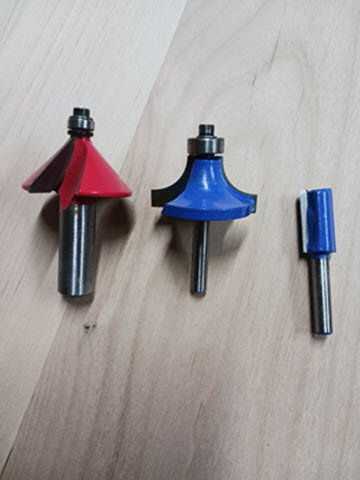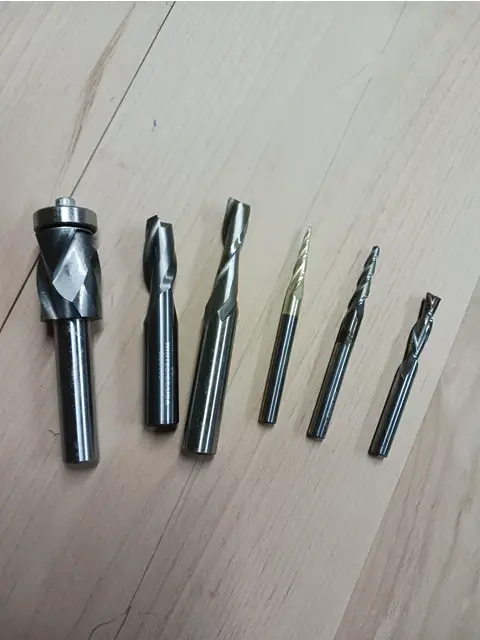Anyone who has been using a CNC router can attest to the fact that the cutting bits will inevitably become blunt. It can happen faster than you might expect, leaving you wondering if you can sharpen them rather than forking out the cash for a new one.
Most CNC router bits can be sharpened by either using hand or rotary tools. Sharpening CNC bits can extend their service life, but doing so may change the dimensions of the bit.
Read on to learn more about how CNC router bits (and regular hand-held router bits) are sharpened and how this will affect their ability to cut accurately. Learning to do this can save you money that you would otherwise spend on new ones, but it isn’t always recommended.
How To Sharpen CNC Router Bits
Now that we have established that you can sharpen CNC router bits, you will be happy to know that it’s fairly easy to do with the right equipment. However, straight bits tend to be much easier to sharpen than their spiral-type cousins.
To sharpen a CNC router bit, you will need a diamond hone. Place the hone on your work surface and hold it in place either with your free hand or a clamp, then place the cutting edge flat against the hone, driving it forward with equal pressure along its length. Repeat this motion 10-15 times, then repeat equally on the other cutting edges.
You may have to repeat the above process several times until you are satisfied with the sharpness of your bit. If you are sharpening an HSS (High-Speed Steel) bit, use a hone with a grit of 300-400. For carbide bits, a grit of at least 600 is recommended. Counterintuitively, using a finer grit (1200 for example) on carbide is actually harmful to the cutting edge. Carbide is brittle and although you will get a sharper edge initially, the edge will chip and dull more quickly.
If you do not have hones, you can get these Trend DWS/CC/FC Fine/Coarse Double-Sided Diamond Credit Card Sharpening Stone (available on Amazon.com) which you can also use for applications like sharpening those dull kitchen knives, among other things. This card will cover you for both carbide and HSS bits. 600 grit side for carbide and 300 grit side for high-speed steel bits.
For Best Results, Use a Lapping Fluid
Using a dry hone will work to sharpen your CNC router bits, but the stone will get clogged up with the fine metal particles it removes before long. You will notice that before long, it will feel as if the stone itself has become blunt. This is where the lapping fluid comes in.
You can use a small amount of machine oil or soapy water to “lubricate” your hone. This might seem counterintuitive, but rather than settling in the pores of the stone, the metal particles will be suspended in the fluid, making the whole process more effective.
There are also specialty lapping fluids available – Trend DWS/LF/100 Diamond Abrasive Lapping Fluid (available on Amazon.com), for example, is specifically designed for diamond grit stones and will perform better than oil and will give you a more satisfactory result.
Sharpening Straight Blade CNC Router Bits
It is best to sharpen your straight blade router bits using a simple flat diamond grinding stone or plate such as this Trend Diamond Credit Card Sharpening Stone found on amazon.

If the router bit has a bearing on the end, remove it before sharpening. With this Credit Card Sharpening hone held tightly to your workbench, apply some lapping fluid and stroke the flat side of each flute 10 times across the stone. Apply even pressure and do not favor the cutting edge of the blade.
Do not attempt to sharpen the beveled edge of the bit as this runs the risk of changing the profile shape.
It is true that even by sharpening the back of the blade, the profile diameter is changing (very little) the profile shape will remain consistent. For this reason, it is recommended that a bit not be sharpened more than 5 times – depending on the blade area.
Establish a routine to touch up these blades every so often.
Sharpening Spiral CNC Router Bits With Rotary Tools
I highly recommend that you either get a professional to sharpen spiral bits or just replace them. I am including these paragraphs in this article in case someone wants to give it a shot. Many people do and many people are successful at it. I am not.
These steps apply best to HSS bits and not so well to carbide bits.
You can use power tools such as a Dremel or grinder to “sharpen” your spiral bits but with these, you will actually be grinding away the dull spiral edge and re-dressing the end of the bit. If you are careful and have a steady hand, you can do this but the effort may not be worth it.
If you are equipped with a rotary tool like a grinding wheel or a Dremel, you can save yourself a lot of time and effort by using it to sharpen your CNC router bits rather than doing it by hand. Keep in mind that you will need a diamond wheel to accomplish this task and it is not a recommended method for sharpening carbide bits.
When using rotary tools, ensure that you wear safety glasses and observe all necessary safety precautions. If you have not been trained to use rotary tools, it is recommended that you do not attempt to sharpen your CNC bits at the risk of serious injury.

Using a Dremel Tool To Sharpen Spiral CNC Bits
You will need a diamond wheel – Dremel EZ545HP 1-½ Inch EZ Lock Diamond Wheel (available on Amazon.com) offers pinpoint precision and a highly durable cutting wheel that will last much longer than your run-of-the-mill cutting wheel.
Once again, you are aiming for the flat edge of the bit. If you own a bench vice, you can secure your router bit in it for more stability. Use the Dremel to gently and evenly sharpen the flat edge. Rotate the bit as necessary to accomplish this on all applicable edges. If you are doing this by hand, consider wearing gloves as a precaution.
Using a Bench Grinder To Sharpen Spiral CNC Bits
You cannot use any old grinding wheel to sharpen CNC bits, so if you don’t have one, invest in something like this BEAMNOVA 6 Inch Diamond Lapidary Grinding Wheel (available on Amazon.com) – it is self-sharpening and can be used for a wide range of materials. Keep in mind that you will only be able to reshape the tip, so if your flutes are blunted your bench grinder won’t do you any good.
To sharpen your CNC bit with a bench grinder, start the grinder and make sure it is running at full speed before making contact. Flatten the tip first until you get it down to a sharp cutting edge, then use the corner of the rotary stone to gently “kiss” each flute until you get a satisfactory edge.
Bench grinders are not recommended for sharpening CNC bits since they do not offer as much accuracy as a Dremel tool. Review the video below to see how it’s done. I recommend using the lapidary grinding wheel mentioned above rather than the standard grinding wheel used in this video. If you are to sharpen your CNC router bits often, you may want to come up with some jigs to help set the proper angles on the end of the bit. You will get better results.
Weigh Up the Cost/Benefit – It May Not Be Worth the Effort
CNC router bits come in all shapes, sizes, and perhaps most importantly, price points. Sharpening a bit can take a lot of time – especially if you are doing it by hand – so unless the bit you want to sharpen is expensive or difficult to get, you may be better off simply buying a new one.
Sharpening Bits Changes Their Dimensions
When you sharpen a bit you are removing material from it, and while you might not see it with the naked eye it does change the profile size. You will have to compensate for the change in size using the software that is running your CNC router.
While it might seem like a good idea at first blush, getting into the habit of sharpening bits and compensating for the changing dimensions can cost you down the line – especially if you start accumulating resized bits.
You may someday end up with an important job and grab a bit out of your collection, only to find at the end of your CNC run that you have excess material. This will necessitate re-running the job, which can cost you time and resources.
Clean Your Bits So They Last Longer
Sharpening CNC router bits can help you get that pressing job done in a pinch, but like any tool, proper care is essential to ensure you get the most out of it. Be sure to remove the bit from your machine to make life easier.
To clean your CNC bits, you will need the following:
- Stiff Brush – an old toothbrush is perfect, or any other old brush you have lying around.
- Cleaning Solvent – alcohol and kerosene work great as cleaning agents but for best results use Trend CLEAN/500 Tool Cleaner Wood and Resin Remover (another Amazon Link.)
- Container – you will need a container to hold your cleaning solvent that is big enough to dip your brush into.
- Rag – you will use this to catch any debris.
- Gloves – solvents are harmful to your skin, so it is important to protect your hands. Rubber or latex gloves should do the trick. However, if you use the Trend Clean/500 mentioned above, there are no harsh chemicals in the cleaner.
The method for cleaning your CNC bits is simple – dip your brush in the solvent and gently brush off any debris stuck to your bit, catching it in your shop rag. Once you are satisfied, let the bit dry and stow it until you need it again.
Conclusion
CNC router bits can be sharpened, and it isn’t a difficult task to accomplish for most bits, provided you have the right materials. Whether it’s worth the effort or not depends on the individual.
| Remember: 1. Only sharpen the flat surface of straight bits. 2. It is better to grind down Spiral Bits to the sharp edge and then re-dress the end of the bit. 3. It is not addressed in the article, but attempting to sharpen compression bits is better left to the professionals. 4. Wipe off your bits after every use and lubricate and store them in a dry place. 5. Clean off the built-up pitch deposits at regular intervals. 6. Sharpen your bits at regular intervals even if they don’t seem dull yet. |
With the right tools, you can extend the life of your CNC router bits, but you can also do this by ensuring that you clean them properly between each use.

